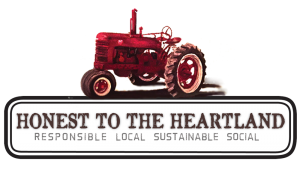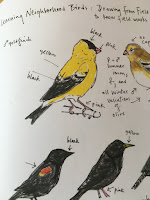 |
Family Nature Journal:
Option 4, the Family Nature Blog |
"Standing there one day, I was transported into another world. I watched native trout and underwater viewing window. Above and below were muskrats and local birds, and I was told that deer and even an occasional elk wander into the viewing area. I was struck by a thought and question: first this room and its living view beats TV; and second, what if a neighborhood were structured around a rehabilitated wildlife habitat?"
– Richard Louv, from "Creating Every day Eden, Backyard Revolution"
As we begin a more explicit attempt at re-naturing our lives by finding good daily practices and imagining our homes as nature centers, one thing becomes very obviously clear: there are a few common tensions that compete for our time in these projects. Some of these tensions are bound to be exclusive to each family's life style, work schedule, extracurriculars, social, etc; but one that we will all likely have in common is the great balancing act between "screen time and green time." A very eye-opening article from 2010
NYT was titled, "If your kids are awake, they are probably online." The article went on to make a point that for many of us, especially kids, usually some form of digital media is turned on and being absorbed throughout the day, as a kind of built-in companion, if you will. It may be music, it may be the phone, internet, TV, but taken as a whole it surrounds us and becomes nearly visible, a similar role, one can imagine, that nature used to play in our lives. The true trick then in a modern environment is first to recognize this media surrounding, and then begin the journey of re-naturing some of that time, for the sake of balance and well-being. Louv and others involved in human restoration have spent a lot of time trying to provide us with as many examples and tools for doing this as they can find. Certainly creating one's own home and yard as a newfound source of 'nature time' is a great start. But to keep the project alive, and to keep it engaging and realistic in terms of interest, we need specific practices and modes of creation.
I have found that placing my various interests in nature, food and travel into a blog is a great way to keep these projects low pressure, low profile, but also accountable. The nature blog is a few things at once: first, ideally, the blog post is in reaction to some time spent outside, doing something, observing something, thinking, researching, running around outside, or whatever. Whatever style the blog post takes hardly matters – some nature writers thrive in relating nothing more than descriptive journal entries, others scientific observations, others outdoor adventures written in narrative form, even poetry. To keep a blog alive and restorative, so to speak, it needs to release from other standards of perfection or deadline. Blog posts are thoughts in action, they are hopefully loose, and don't necessarily need to be edited. In other words, they can be fun and kids will like them.
The second obvious point to make about the potential family nature blog is that they are indeed screen time and visually oriented, but a 'nature deal' I am willing to make. The set up for the blog entry is natural discovery. The blog format also allows for personally taken photographs of nature or even self-created art! Use a quote from a nature writer for inspiration...the blog post might include reading! All of this creates a pleasing sense of not only accomplishment, but it is a permanent testimony to experience and can be archived to view for yourselves, but it also, by its very definition of being a blog, is a sharable contribution. For grandma to be able to watch the family 'nature journey' from afar is bound to be special for all participants. If the blog 'practice' gained momentum and stuck as a ritual, is it possible that kids could share among themselves their own nature blogs? In the realm and scheme of things, I have to say I would be far more tickled by the prospect of a nature blog friendship than a Facebook friendship. One is educational, fun, experiential, and moving toward the direction of a wholistic goal; the other a short, clipped advertisement for self that includes virtually no substance. One seems permanent, alive and restorative; the other passing, artificial, and ultimately energy depleting.
Option 4: Create your own family blog site. Blogger or
Word Press offers very simple free blog services that work seamlessly well. The process might take 20 minutes, maybe an hour if the design of the page is really important. Experiment with a beginning posting structure that can be used over and over again to start, then let your own form take shape over time. I like to bring in a personal photo of nature, then write a quote of inspiration from a nature writer next to the picture. Then I begin my own writing, whatever the topic might be. The easiest writing to start with is the simple descriptive journal entry. "This afternoon, we (I) decided to walk around the block only looking at the front yard gardens. This time of year we saw mostly ________. The sky above was __________ I remember one day thinking what it would be like to live near water....the last Monarch of the season flitted past. Monarchs are amazing look like stained glass in flight. Without looking as much at the houses and more at just the nature, I began to realize we lived inside a forest....."
Any of these impressions can lead to not only more writing (patience in writing literally takes time and practice!) but to quick research projects, art, knowledge. When we quickly evaluate this entire process, all for the sake of colorful, artful, thoughtful, blog page, in comparison to virtually any form of media consumption, they don't even compare. Over time, we actually begin to intuitively come to grips with this difference and will become more attractive to the restorative process of creating, than the depleting process of absorbing. At the end of the first blog post, plan for the next one. This is thinking like a writer and researcher – what do I create next? Parents may need to set out a sticky note reminder for that day's 'outdoor adventure' and blog entry. Remember that it can be edited at any time after publication if desired.
































